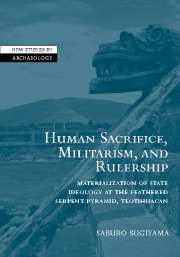 Human Sacrifice, Militarism, and Rulership
Human Sacrifice, Militarism, and Rulership Book contents
- Frontmatter
- Contents
- List of figures
- List of tables
- Acknowledgments
- 1 Introduction: cognition of state symbols and polity
- 2 Background: data and ideation
- 3 The Ciudadela and the city layout
- 4 Architecture and sculpture
- 5 Burials
- 6 Offerings
- 7 Overview: sacrificial and elite burials
- 8 Conclusion: the Feathered Serpent Pyramid as symbol of sacrifice, militarism, and rulership
- Notes
- References
- Index
4 - Architecture and sculpture
Published online by Cambridge University Press: 22 September 2009
- Frontmatter
- Contents
- List of figures
- List of tables
- Acknowledgments
- 1 Introduction: cognition of state symbols and polity
- 2 Background: data and ideation
- 3 The Ciudadela and the city layout
- 4 Architecture and sculpture
- 5 Burials
- 6 Offerings
- 7 Overview: sacrificial and elite burials
- 8 Conclusion: the Feathered Serpent Pyramid as symbol of sacrifice, militarism, and rulership
- Notes
- References
- Index
Summary
Monumental architecture and sculpture have been found at the FSP, and murals at related structures in the Ciudadela. The assumption underlying this chapter is that both architectural style and iconography at the FSP formed the final stages of a single construction program that began with the preparation of the burial complex and offerings discovered during excavation. One might logically expect to find some sort of coherent ritual meaning among architecture, iconographic representations on the sculptural facade, and the burial complex dedicated to that structure, all of which were related to the erection of the FSP and may also have been a part of a larger state program. Here, I discuss possible ritual messages encoded in the pictogram of the pyramid.
In the section on architecture, construction stages and other architectural features are discussed in terms of symbolic aspects; the second section deals with stone carvings on the facades of the FSP, which express the main visual messages of the pyramid; and the third section concerns burned clay fragments found on top of the Adosada, which were probably from walls of the temple atop the FSP and which were contemporaneous with and complementary to those of the facades. I end the chapter with some concluding remarks on the overall context of imagery at the FSP.
Architecture
That the FSP was the principal pyramid at the Ciudadela is suggested by its size and central location.
- Type
- Chapter
- Information
- Human Sacrifice, Militarism, and RulershipMaterialization of State Ideology at the Feathered Serpent Pyramid, Teotihuacan, pp. 53 - 86Publisher: Cambridge University PressPrint publication year: 2005


